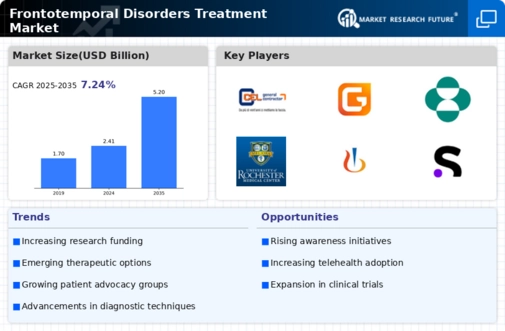Market Growth Projections
The Global Frontotemporal Disorders Treatment Market Industry is projected to experience substantial growth over the next decade. In 2024, the market is estimated at 2.41 USD Billion, with expectations to reach 5.2 USD Billion by 2035. This growth trajectory indicates a robust compound annual growth rate (CAGR) of 7.24% from 2025 to 2035. Factors contributing to this growth include increasing prevalence, advancements in research, and the development of novel treatment options. As the market evolves, stakeholders are likely to focus on innovative strategies to address the challenges posed by frontotemporal disorders, ensuring that patients receive the necessary care.
Emergence of Novel Therapeutic Options
The Global Frontotemporal Disorders Treatment Market Industry is witnessing the emergence of novel therapeutic options, which is a key driver of market growth. Recent developments in pharmacological treatments and non-pharmacological interventions are providing new avenues for managing frontotemporal disorders. These innovative therapies aim to address the diverse symptoms associated with the condition, improving the quality of life for patients. As more treatment options become available, healthcare providers are better equipped to tailor interventions to individual patient needs. This diversification of treatment modalities is expected to enhance market dynamics and contribute to the overall expansion of the industry.
Advancements in Research and Development
The Global Frontotemporal Disorders Treatment Market Industry is significantly influenced by advancements in research and development. Ongoing studies are uncovering the underlying mechanisms of frontotemporal disorders, which may lead to novel therapeutic approaches. For instance, the exploration of genetic factors and biomarkers is paving the way for personalized medicine. As these innovations emerge, they are likely to enhance treatment efficacy and patient outcomes. The commitment to R&D is crucial, as it not only addresses current treatment gaps but also aligns with the projected market growth, with a CAGR of 7.24% anticipated from 2025 to 2035.
Rising Awareness and Education Initiatives
The Global Frontotemporal Disorders Treatment Market Industry is positively impacted by rising awareness and education initiatives. Campaigns aimed at educating healthcare professionals and the public about frontotemporal disorders are crucial for early diagnosis and intervention. Increased awareness leads to more individuals seeking treatment, which in turn drives market growth. Organizations and advocacy groups are actively working to disseminate information, thereby reducing stigma and encouraging patients to pursue care. This heightened awareness is likely to result in a larger patient population, further fueling the demand for effective treatment options in the coming years.
Growing Investment in Healthcare Infrastructure
The Global Frontotemporal Disorders Treatment Market Industry benefits from increased investment in healthcare infrastructure. Governments and private entities are recognizing the importance of mental health and neurological disorders, leading to enhanced facilities and resources. This investment facilitates better diagnosis, treatment, and support for patients with frontotemporal disorders. Improved healthcare systems are essential for managing these complex conditions, and as funding increases, the market is expected to expand. The focus on building comprehensive care models is likely to contribute to the overall growth of the market, ensuring that patients receive timely and effective interventions.
Increasing Prevalence of Frontotemporal Disorders
The Global Frontotemporal Disorders Treatment Market Industry is experiencing growth due to the rising prevalence of frontotemporal disorders. As awareness increases, more individuals are diagnosed, leading to a greater demand for effective treatments. In 2024, the market is projected to reach 2.41 USD Billion, reflecting the urgent need for innovative therapies. This trend is expected to continue as the population ages, with projections indicating that by 2035, the market could expand to 5.2 USD Billion. The increasing number of patients necessitates the development of targeted therapies and support systems, thereby driving market growth.


























Leave a Comment